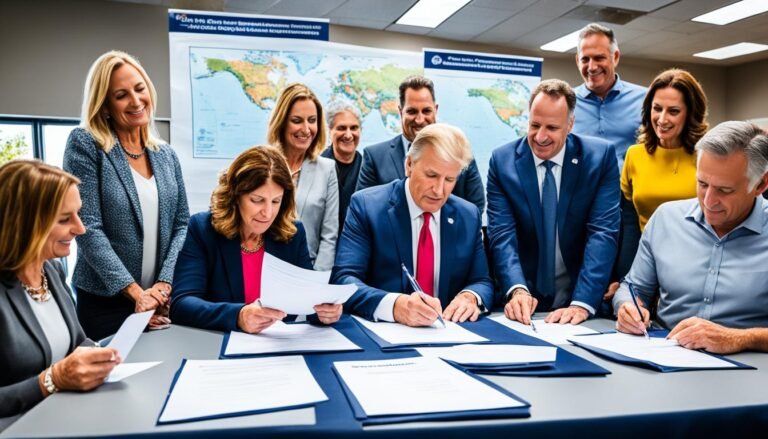FMLA Compliance for Small Business Owners
Did you know that around 27 million people in the U.S. get FMLA benefits? This law allows workers to take time off without pay for certain reasons. These include family or health issues. It aims to keep their jobs safe while they’re away.
Small business owners must follow FMLA rules. This is important for both their business and their workers. We’ll look at the key guidelines and needs for FMLA in small businesses. This info will help you work through this important legal area.
Key Takeaways:
- Understand the importance of FMLA compliance for small business owners.
- Learn about the guidelines and requirements of FMLA for small businesses.
- Discover eligibility criteria for employees to access FMLA benefits.
- Explore how FMLA leave works and the options available to employees.
- Understand when an employer can deny an FMLA request and the valid reasons for denial.
What is FMLA?
FMLA stands for Family and Medical Leave Act. It’s a federal law that gives eligible workers up to 12 weeks of unpaid leave each year. This time off is job-protected.
It’s meant for taking care of family or health needs. For example, you could use it to care for a newborn, a spouse, a child, or a parent with a serious health issue. Or for your own health problem that makes it hard to work.
Using FMLA lets employees put their health and family first. This happens without losing their job or benefits.
Understanding FMLA
The Family and Medical Leave Act (FMLA) offers up to 12 weeks of unpaid leave. It helps eligible employees take time for their family or health. This leave is without risking their job.
You can use FMLA for different important situations. These include caring for a new baby, adopting, or looking after a family member with a serious health problem. It’s also for dealing with your serious health issue.
While on FMLA leave, your health benefits continue. And you’re guaranteed to get your job back or a similar one when you return.
FMLA gives employees the chance to prioritize what matters most without losing their job.
Does the FMLA Apply to Small Businesses?
The FMLA’s reach into small businesses is vital for both sides, employers and employees. Usually, it kicks in for businesses with over 50 workers within 75 miles. Small businesses under 50 employees might still give FMLA leave if they want to help their team balance work and life.
Integrated or joint employers must also follow FMLA if they have over 50 workers across different places within 75 miles.
Small businesses that fit under the FMLA rules should offer FMLA leave. This helps provide important benefits and safeguard jobs for employees. Giving FMLA leave means these businesses support their employees’ needs and health. They help make a good workplace.
To see how the FMLA might work in small businesses, check out the table below:
| Number of Employees | Radius | FMLA Applicability |
|---|---|---|
| 50 or more | Within a 75-mile radius | Must offer FMLA leave and comply with guidelines |
| Less than 50 | Within a 75-mile radius | Have the option to provide FMLA leave |
| Integrated or joint employers | Total employees across multiple branches or locations | Offer FMLA leave if the total exceeds 50 within a 75-mile radius |
Knowing how FMLA applies in small businesses helps both employers and workers. Employers can make sure they follow the law and care for their team. It’s also smart to talk with legal pros or HR experts. They can help you understand and meet FMLA rules.
When Do Employees Become Eligible for FMLA Benefits?
To get FMLA benefits, workers have to meet some rules. They need to work for a big employer, usually one with over 50 workers. Also, they must have worked there for 12 months and done at least 1,250 hours. This is to make sure they really need time off.
This all checks that employees have been with their company a good while. They also need to show they worked a lot during that time. Working 1,250 hours proves they are quite active on the job.
Covered employers are those businesses that qualify to give FMLA benefits. The rule is usually if they have 50 or more workers. But, smaller companies can also do this if they want. This helps their workers balance work and life, which is good for keeping them happy.
There are several reasons why someone could take FMLA leave. They include the birth or adoption of a child. Or if they need to care for a sick family member. Also, if someone is sick themselves and it affects their job.
All these reasons are important for taking care of employees and their families. They ensure that people can be there for each other when health or family situations come up.
Having FMLA benefits shows a company cares about its employees’ lives outside work. This makes a workplace where people feel supported. It helps employees stay happy and loyal.
How Does FMLA Work?
Under FMLA, eligible employees can take up to 12 workweeks of unpaid leave each year. This time off can be continuous or broken up. It depends on why and how an employee needs to take leave. This law helps employees handle their work and life needs better while keeping their job safe.
Employees can use FMLA leave for several reasons, like:
- Getting medical care for a serious health condition
- Taking care of a new child or one they’ve adopted
- Looking after a family member with a severe health problem
- Handling a serious military situation
Using leave a bit at a time can be good for some. For instance, they might need time off for medical checkups or to help family. This way, they don’t have to take all their leave together.
For example, Sarah’s case shows how useful this flexibility can be. She needs to care for her son’s medical needs. With intermittent FMLA, she can go to her son’s doctor’s appointments while keeping her job safe.
Sometimes, employees might need to work fewer hours because of a health issue. Or they might have to take care of someone. In these cases, they can adjust their work time. This makes it easier for them to handle their other responsibilities.
It’s important for everyone involved to know what FMLA offers. This helps make sure that things go smoothly when employees need time off.
Can an Employer Deny an FMLA Request?
Employers can only deny an FMLA request for valid reasons. Employees can request leave only for certain situations. Understanding the rules for FMLA leave is very important. Here are reasons an employer might deny a request:
- Invalid Reason for Leave Request: If an employee’s reason for FMLA leave doesn’t qualify under the act, the employer can say no.
- Failure to Authorize Contact with a Healthcare Provider: Employers need proof from a healthcare provider supporting the leave. Without this, they might deny the request.
- Lack of Proper Notice: Employees must give notice about FMLA leave at least 30 days early. Or, they can do it as soon as possible for sudden cases. If they don’t, their request might be denied.
- Employer Not Meeting FMLA Criteria: The FMLA only covers employers with over 50 workers nearby. If a smaller employer doesn’t meet this, they can refuse the request.
| Reasons for Employer Denial of FMLA Request | Impact on Employees |
|---|---|
| Invalid Reason for Leave Request | Non-qualifying reasons can stop employees from taking FMLA leave. This might affect their or their family’s care needs. |
| Failure to Authorize Contact with a Healthcare Provider | Without proper medical notes, FMLA leave might be denied. This could make getting medical care harder for employees. |
| Lack of Proper Notice | Missing the notice deadline could mean a request gets turned down. It might create work and personal life conflicts for employees. |
| Employer Not Meeting FMLA Criteria | Employees at small businesses not covered by FMLA miss out on protected leave. This leave is important for their and their family’s well-being. |
It’s not common for employers to deny FMLA requests. But it’s vital for both sides to stay in touch and follow the FMLA rules. This way, when needed and qualified, employees can get the leave they deserve.
FMLA Notification Obligations
Both employers and employees must understand their duties regarding FMLA leave. It’s key for everyone to know their rights and what is expected under the Family and Medical Leave Act.
Employer Obligations
Employers have to do several things for FMLA notification. They must post a notice about employee FMLA rights where everyone can see it. This notice should explain the leave options, why leave can be taken, and other important details. By doing this, employers help keep their workers informed and able to get help when needed.
Employee Obligations
When employees need FMLA leave, they too have responsibilities. They should tell their boss they need time off at least 30 days before, if possible. If it’s an emergency or not possible to give 30 days’ notice, employees should tell their employer as soon as they can.
If the employer wants to see a doctor’s note for the leave, employees need to give it. This note must explain why the leave is needed and show it’s really necessary. Employers use this note to check if the leave reason is okay under FMLA and to manage leave benefits correctly.
Employer Response
After an FMLA leave request, employers need to do some things too. They must tell the employee within five working days if their leave is approved under FMLA. This makes sure both the worker and the boss understand the leave situation clearly.
Employers might also ask for a note saying the employee is ready to work again. This note proves the employee is fit to work without any issues. Making sure the employee is ready to come back keeps the workplace safe for everyone.
To wrap it up, employers must inform employees about FMLA rights and quickly handle leave requests. Employees need to give timely notice for leave and provide medical proof if asked. Both groups are vital for following FMLA rules and keeping the leave process fair and clear.
Length of FMLA Leave
FMLA leave is vital for those needing time off. Employees can take 12- or 26-week breaks over a year. They can use this time for their family or health issues without job worry.
Employers set the rules for the 12-month period. Using a rolling period lets workers take leave at various times. This stops employees from using all their leave at once, which can challenge the workplace.
Working in parts is possible with FMLA. Workers can take time off for doctor’s visits or ongoing health needs. But, the company needs to agree, and they try to avoid big interruptions.
FMLA Leave Length Overview
| Leave Type | Duration | Conditions |
|---|---|---|
| Continuous Leave | 12 or 26 weeks | Can be taken in one continuous block |
| Intermittent Leave | 12 or 26 weeks | Can be taken in separate blocks of time for a single qualifying reason |
| Reduced Leave Schedule | Varies | Allows for a decrease in the employee’s usual number of working hours per week or per day |
Knowing about FMLA options helps everyone. Employers and workers can plan leave better. This way, both the work and employee needs are met.
FMLA Legal Protections
The Family and Medical Leave Act (FMLA) provides important rights to employees. It allows them to take time off for specific family or medical reasons. When they come back to work, they must get their same job or an equal one.
Job restoration
is key in the FMLA. Employers must put employees back in their job or a similar one when they return from leave.
“The FMLA ensures that employees can take the leave they need without fear of losing their jobs or suffering adverse employment actions.”
If an employee is a “key employee” or if giving back the same job isn’t possible, there’s an exception. This might happen if the company has drastically changed since the employee left.
If employers break the FMLA rules, they can face serious penalties. They might have to pay for the employee’s losses or cover legal costs.
The FMLA also says employers can’t punish workers for using their FMLA rights. This means they can’t treat them unfairly or fire them for taking time off under FMLA rules.
Examples of FMLA Violations
Employers need to know what not to do when it comes to FMLA. Not giving eligible employees time off, or treating them badly when they come back, are common mistakes.
- Wrongfully denying an employee’s FMLA leave request despite meeting the eligibility criteria and providing proper notice.
- Terminating or demoting an employee after they return from FMLA leave.
- Refusing to restore an employee to their previous position or an equivalent position upon their return.
- Interfering with an employee’s FMLA rights or discouraging them from taking FMLA leave.
Stay Compliant and Protect Your Business
To steer clear of FMLA issues, employers should know the rules well. They should also make sure their managers are trained. Good communication with employees about FMLA rights and rules is crucial.
FMLA compliance is good for everyone. It helps create a workplace where employees feel respected. It can also prevent legal trouble for employers.
| Violation | Consequences |
|---|---|
| Wrongful denial of FMLA leave | Orders to restore leave, payment for expenses caused by denial, attorney’s fees |
| Retaliation against employees | Possible legal action, monetary damages, reputation damage |
| Failure to restore employee to previous position | Possible legal action, orders to restore position, monetary damages |
Following the FMLA is both legally required and good for business. It shows a company cares about its people. And it protects the rights of employees.
Conclusion
Keeping up with FMLA regulations is key for small businesses. It makes sure employees’ rights are respected. Small business owners need to know the FMLA rules, who can use them, and when to tell their employees.
To stay on track, talking to HR experts or lawyers can be very helpful. They can offer good advice to make sure you’re doing things right. This protects your business from getting into legal trouble.
Caring about FMLA matters a lot. It shows employees you’re looking out for them. Following FMLA rules helps businesses create a place where people trust each other. It makes a positive atmosphere at work.
Small business owners are a big part of keeping FMLA compliance in check. They must check and update their rules often. By knowing the latest on FMLA and getting help if needed, they can meet their duties. This leads to a work setting that is fair and satisfying for everyone.







